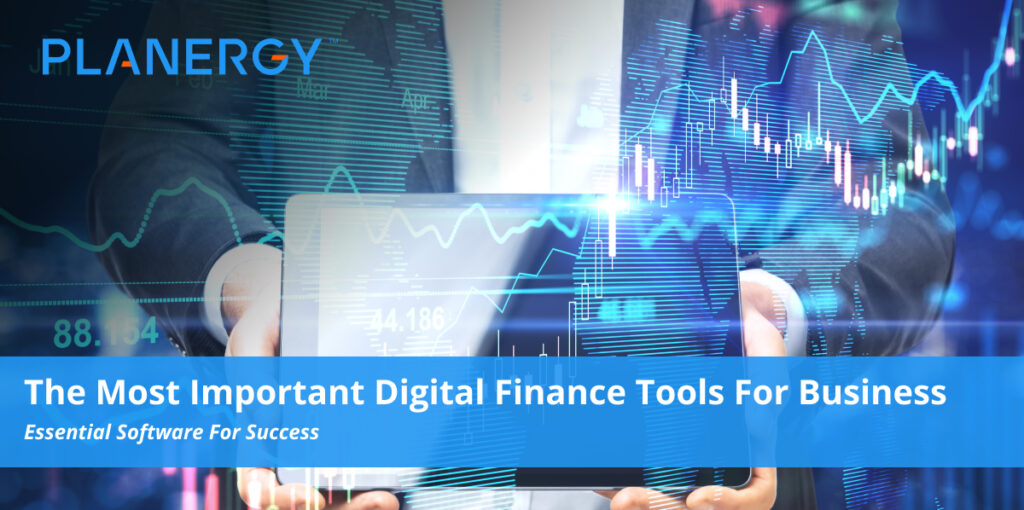A killer business model and exceptional goods and services are two of the flashier ways companies can set themselves apart from the competition in today’s crowded market. But in a world where Big Data has become the fuel driving the engine of innovation and pumping the pistons of profitability, it’s the unglamorous but powerful parts of doing business—e.g., choosing the right digital finance tools—that can make a truly significant difference in an organization’s profits, agility, resilience, and competitive strength.
Which digital financial tools are best for you? There’s no one answer. But by making sure you have the essentials in your kit, you’ll be ready to leverage your data, support your digital transformation efforts, and ensure you’re ready to compete in the new normal.
Why You Need the Best Finance Tools for Business
As of Q1 2021, the world is still emerging from the heavy shadow of the COVID-19 novel coronavirus pandemic. The new normal has done more than upset traditional paradigms and reinforced the importance of remote capabilities and collaboration. It’s also reminded all organizations, from startups and small businesses to global corporations, of the critical importance of proper software tools in an economy where information is the greatest asset at their disposal.
Financial planning and budgeting. Process optimization. Managing cash flow. Payroll management and bookkeeping. Procurement optimization and inventory management. These are just a few of the functions that depend upon clear, clean, and complete data—and require the best available financial tools to ensure good data is swiftly and accurately transformed into actionable insights and smart business decisions. These needs are especially critical for small businesses, freelancers, and startups, all of which need every advantage they can get to compete with larger organizations who have access to greater resources and budgets.
Investing in the right tools can mean the difference between your small business pulling ahead of the pack and struggling to keep its head above water.
As more companies look for ways to transform their procurement and finance functions into sources of strategic value and process improvements as well as cost savings, having the right automation and accounting tools, along with best-in-class expense management software, is key.
Essential Digital Finance Tools for Your Business
The link between a company’s financial management and its competitive strength is tighter than ever before. As more companies look for ways to transform their procurement and finance functions into sources of strategic value and process improvements as well as cost savings, having the right automation and accounting tools, along with best-in-class expense management software, is key.
Regardless of your business model, the optimal financial management and accounting tools will likely be cloud-based, designed for integration, and supported by a strong, centralized framework powered by automation, artificial intelligence, and next-gen data analytics.
1. Procure-to-Pay Software
The last thing you want to do is build your company’s fortress of financial management on shifting sands. Investing in purpose-built, customizable procure-to-pay (P2P) software like Planergy gives large and small business owners a powerful framework for centralizing and optimizing their software environment—and establishing a firm foundation for digital transformation across their entire organizations.
The right solution introduces machine learning, robotic process automation, and advanced data management tools into your workflows, connecting all your other applications and ensuring your team has leveled, role-appropriate, and real-time access to the information that drives all your business activities.
Ideally, the P2P solution you choose will:
- Be delivered using software-as-a-service (SaaS), reducing the organization’s carbon footprint and resource usage by eliminating paper and waste while minimizing the need for local IT staff and equipment.
- Be centralized, cloud-based, and comprehensive, collecting and organizing data from diverse sources and making it available for real-time access, analysis, and reporting.
- Provide platform-agnostic access from both mobile and desktop devices.
- Integrate with all your other applications, including accounting software, enterprise resource planning (ERP) solutions, customer resource management (CRM) platforms, etc. to remove data silos. It uses templates to streamline processes and standardizes file formats and storage/access protocols, too.
- Provide an eCommerce-style guided buying experience, eliminating maverick spend and invoice fraud while making it easier to stick to budgets, secure optimal pricing and terms, etc.
- Use robotic process automation and continuous improvement via machine learning to eliminate human error, minimize the need for human intervention, and improve the speed and efficiency of high-volume, repetitive workflows.
- Provide exceptional spend management, category management, inventory management, and financial reporting capabilities.
- Streamline and optimize all your procurement processes, from creating purchase orders to paying the final vendor invoice—with support for advanced capabilities such as supplier catalog integration and automatic three-way matching.
- Directly support business-critical tasks like budgeting, expense tracking and reimbursement, payroll management, bookkeeping, accounts payable and more by providing complete visibility into, and control over, all financial data.
- Center procurement and AP as value creation centers aligned with organizational goals.
Choosing the right P2P provider will make it much easier to get optimal performance from the other software tools in your kit.
2. Accounting Software
You have a lot of options when it comes to choosing accounting software for your business. Small business accounting, for example, requires a less robust solution than what might be used by a global manufacturer.
But even small businesses need to move beyond the traditional Excel spreadsheets if they want to compete effectively. Whether you use Freshbooks, QuickBooks, Xero, or something else, make sure the option you choose is cloud-based, has integration capabilities with your P2P solution and other management software, and provides audit-friendly financial reports, budgets, and balance sheets.
Your accounting software should also include dedicated close capabilities, with checklists and automatic tracking of month-end processes. Full data visibility and process automation can take a lot of the stress and error out of a traditionally harried and time-consuming process, improving the strategic utility of the month-end balance sheet by shortening the amount of time needed to actually close the books.
3. Budgeting Software
Traditionally, budgeting has gone hand in hand with cash flow management. But it’s playing an increasingly important role in project management and strategic planning as technology makes it possible to set and adjust budgets to meet changing conditions and updated goals.
It’s possible (or even likely) that the P2P or accounting software package you choose will have built-in budgeting capabilities. But if you use a standalone product, make sure it’s readily integrated with your accounting software and P2P system.
4. Invoicing Software
While it’s on the other side of the accounts payable coin, accounts receivable benefits just as much from optimization.
Support for electronic invoicing (eInvoicing) and automated approval workflows eliminate paper, wasted time, and frustration for both you and your customers. Support for multiple payment options (e.g. PayPal, credit cards, direct payment from the customer’s bank account, etc.) will help remove obstacles to payment and can provide insights on which payment methods your customers use most.
It also generates data that can be mined for actionable insights and strategic benefits such as special terms and pricing for your best customers or collaborations to develop new products.
In addition, integration with your datasphere ensures you’ve got clean and complete information you can rely on when issuing invoices and preparing for tax time.
5. Expense Tracking and Management
As with budgeting software, top shelf P2P and accounting suites have expense management built in as part of their core functionality. If you’re using a standalone expense tracking and reimbursement solution, make sure it meets your needs (without overwhelming you with options), is cloud-based, and integrates seamlessly with your accounting and P2P solutions.
Look for a package that makes it as easy as possible for your team members to record and manage their business expenses. Cloud-based, mobile-friendly solutions will simplify tracking expenses and increase the likelihood of timely, complete, and accurate submissions. Integration with your main systems will make it much easier for your finance team to review and approve or reject business expenses as they enter the system.
6. Payroll Management
Scalability and full integration with your accounting and P2P software are the primary concerns with payroll management solutions. Choose an option that grows with your business. Make sure it includes any special features you might need (e.g., time tracking, direct deposits to employee bank accounts, etc.) and can utilize information pulled from your centralized data repository to speed processing times and improve accuracy. This will reduce the risk of costly errors and ensure your team members are being fairly and completely compensated.
7. Inventory Management
If your P2P solution doesn’t already have an inventory management module (if it doesn’t, it might be time to go shopping for a better one), look for one that’s scalable, integrates fully with your software environment, and supports emerging technologies such as the Internet of Things (IoT). Full integration and support for tech such as RFID tags, GPS, mobile sensors and more make it easier to forecast demand, automatically replenish orders, and transfer inventory where it’s needed most without the risk of unnecessary expense and waste from redundant orders or lost goods.
8. Cash Flow Management Software
Having a clear view of your working capital is essential when you want to cover the bills but still have the cash you need for growth, innovation, or emergencies. Again, integration with your main systems is crucial here, as managing cash flow effectively is essential to forecasting, budgeting, and deciding whether to capture early payment discounts when you’re paying suppliers.
9. Tax Preparation Software
Finding a solution that’ll help you calculate just how much you owe the tax man is another area where you’ll have no shortage of choices. You can take some of the sting and expense out of dealing with taxes by choosing software that integrates with your other software.
Find a solution that will let you download inventory reports, sales figures, payroll information, and other data directly from your system, complete with audit-ready transparency, and pay with confidence.
Building a Better Business Requires the Best Software Tools
Want to generate maximum value, savings, and efficiency from your financial management and planning? Make sure you’ve invested in a best-in-class P2P solution. Choose complementary software applications that take full advantage of its capabilities, share data seamlessly, and can be accessed from wherever your team needs to work. By crafting the right financial toolkit for your business, you’ll be ready to get an optimal return on all your financial activity—and use your financial data to drive innovation, value creation, and profitability for your entire organization.




